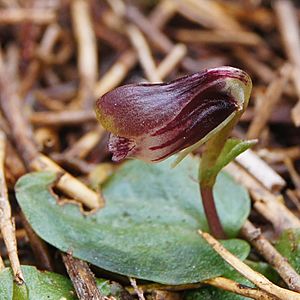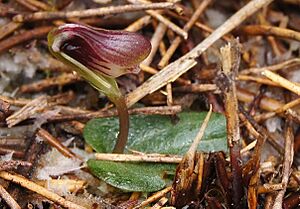Swamp helmet orchid facts for kids
Quick facts for kids Swamp helmet orchid |
|
|---|---|
 |
|
| Conservation status | |
 Nationally Critical (NZ TCS) |
|
| Scientific classification | |
| Synonyms | |
|
Corybas carsei, also known as the swamp helmet orchid, is a special type of orchid that only grows in New Zealand. It's found in just one place, the Whangamarino Wetland in the Waikato District. This orchid is super rare, with fewer than 250 plants left, which means it's in big trouble and needs our help!
Contents
What Does It Look Like?

This small orchid grows from a single leaf that is about 1 to 2.5 centimeters (0.4 to 1 inch) long. It blooms with a single flower between September and November. The flower stands only 1 to 3 centimeters (0.4 to 1.2 inches) tall.
It looks like it's wearing a tiny hood! This is because its top petal, which is maroon, covers most of the other petals. The other petals are white with a maroon bottom and have pink or maroon stripes.
After flowering, it grows a seed pod that is 5 to 6 centimeters (2 to 2.4 inches) tall. This pod holds tiny, dust-like seeds that the wind carries away. Just like many other orchids, these seeds need help to grow. They rely on a special fungus to give them the energy they need to sprout.
How It Got Its Name
The swamp helmet orchid was first described in 1912 by a person named Thomas Frederic Cheeseman. He named it Corysanthes carsei after Harry Carse. Harry Carse was a schoolteacher who, along with Blen Matthews, found the first example of this plant near Lake Tangonge in Kaitaia.
Later, in 1945, the orchid was moved to a different group of plants called Corybas. This is why its name changed to Corybas carsei.
Where It Lives
The swamp helmet orchid loves open, wet areas that have been disturbed a bit. It grows best among tiny plants like liverworts and mosses. Today, it is only known to live in the Whangamarino Wetland.
Saving the Swamp Helmet Orchid
The New Zealand Government's Department of Conservation (DOC) says the Corybas carsei is "threatened - nationally critical." This means it's very close to disappearing forever.
Why It's in Danger
The biggest problem for the swamp helmet orchid is when wetlands are changed. This happens when land is drained for farms or when too many nutrients from farming get into the water. These extra nutrients help other plants grow very thick and tall, which can cover up and "swamp" the small orchids.
This orchid used to be found in many places, from Kaitaia in the north to Moanatuatua Swamp in the south. But by the middle of the 1900s, people thought it had completely died out.
Rediscovery and Rescue
Luckily, in the early 1980s, it was found again in the Whangamarino Wetland, near Te Kauwhata. This happened during a survey to stop plans to drain the wetland.
In the past, Whangamarino often had fires started by people clearing land or by steam trains. But after the 1960s, fires were stopped. This caused the plants in the wetland to change. The open, mossy spots that the orchids liked turned into tall grasses and sedges. By 1991, there were only about 30 Corybas carsei plants left in the wild.
Helping the Orchids Grow
To save the species, the Department of Conservation (DOC) started a special plan in 1994. They began to set small, controlled fires in fenced areas during winter. The ground was damp then, so the deep peat soil wouldn't catch fire. This was done to copy the natural fires that used to happen.
After a fire, more Corybas carsei plants appear, and they flower and make seeds much more often. Without these fires, only a few orchids bloom each year. So, now, a winter burn every seven years is part of the plan to help them survive.
Protecting Their Home
The Corybas carsei is so rare and special that when New Zealand Geographic magazine wanted to take pictures, they were only allowed to do so if they promised not to tell anyone the exact location of the plants. This helps keep them safe.
The DOC calls its status "Nationally Critical" because there are so few plants (less than 250), they live in only one tiny area, and they need constant care to survive. Thanks to these efforts, their numbers have slowly grown, from 77 plants in 2008 to 195 in 2011.

